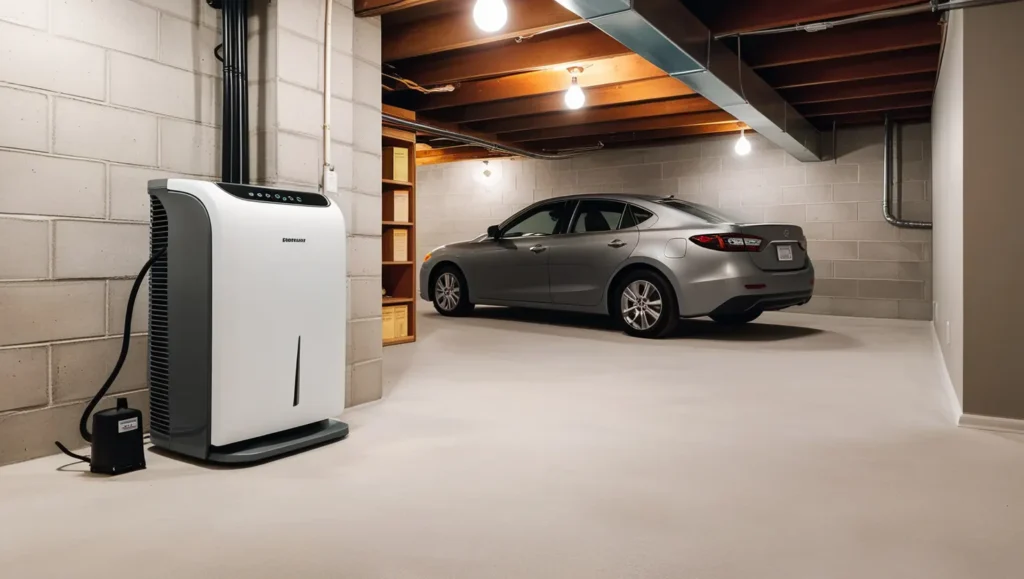Dehumidifier for Basement
Dehumidifiers are highly used for basement areas. But still, there is a lot of confusion about this, the majority of people don’t know how to choose, what to choose before buying a dehumidifier.
There are 4 things you must follow before you buy any dehumidifier for your basement.
- How capable your dehumidifier is of operating in low temperatures.
- When you should go for a desiccant dehumidifier.
- Water drainage options for the dehumidifier.
- What kind of features does the dehumidifier provide to operate smoothly. Like, passive defrost mode, defrost mode, auto-compressor off, Auto restart, Continuous mode, timer option, etc.
Dehumidifiers in low temperatures:
There are two kinds of dehumidifiers, *compressor or refrigerant type and *desiccant type. For the basement area, we use a compressor/refrigerant-type dehumidifier. Normally in basement the temperature is lower than the room temperature. And that’s an issue with the compressor-based dehumidifier. This kind of dehumidifier doesn’t work well it low temperature.
Why compressor/ refrigerant type dehumidifier doesn’t work well in cold places:
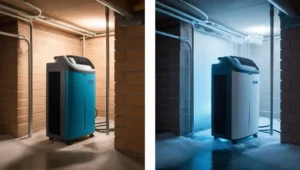
Imagine you have two basements with similar moisture/humidity levels, Basement A and Basement B. The temperature of Basement A is 30 degrees Celsius & Temperature of Basement B is 17 degrees Celsius. And you are using an 80 Pints/day capacity dehumidifier in those two Basements. You will notice that in Basement A the dehumidifier is working well. Because it has a higher temperature. In the meantime the dehumidifier in Basement B is not working well, it’s working at very low capacity. Also if you run it for a day, you will notice that the Basement B dehumidifier is freezing up. Because its temperature is very low.
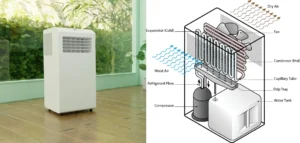
It’s happening because the refrigerant dehumidifier works with the refrigeration cycle, the chilled liquid refrigerant gas flows through the evaporator. During this process, the evaporator gets colder than the Basement temperature. When basement moisture air comes to the evaporator, a heat exchange happens between them due to the temperature difference. Here the evaporator absorbs the heat from room air and the moisture in the air gets cold and heavier by losing heat. Because of that, the cold heavy moisture is stuck to the evaporator and then it collects in the water pot of the dehumidifier.
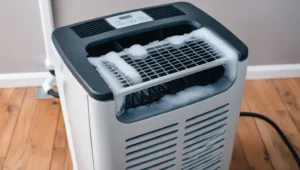
But in cold weather, the moisture in the air is already cold. When this cold moisture comes to the evaporator, heat exchange happens much less compared to a high-temperature area. Because of that in cold areas, refrigerant dehumidifiers work in very low capacity.
And if the temperature of your area is very cold, then cold moisture can freeze-up over the evaporator.
In that condition, you should go for a desiccant dehumidifier.
Nowadays every dehumidifier company tests their dehumidifier in low temperatures
(18 degrees Celsius/65°F). So that the maximum ability of a dehumidifier can be tested. Before that, they tested the dehumidifiers at 26°C/80°F. By testing in low temperatures companies can find out that in low temperatures, what kind of issues can happen. And they add a lot of different modes for batter control even if the dehumidifier gets frizz-up. In the end, we will explain how different modes work in a dehumidifier.
Desiccant Dehumidifier:
The desiccant dehumidifier is completely different from the refrigerant dehumidifier. Basically, a desiccant dehumidifier uses silicon gel to absorb moisture from the air. Silicon gel can absorb water up to 40% of its weight. The main component of a desiccant dehumidifier is the desiccant rotor. The desiccant rotor in the dehumidifier rotates slowly. When the process air/room air goes through the desiccant rotor, the silicon gel in the desiccant rotor absorbs the moisture from the air. This stuck water goes out by a different process.
It can operate in areas where the temperature is less than 10°C. It’s a simple, practical, and easy-to-use device to control humidity in the basement. It provides more efficiency, control and reliability compared to the refrigerant type dehumidifier.
There are some disadvantages also, like it is hard to install, you can’t easily change the location of it and in the beginning it cost more.
It is mostly used for industrial areas where maximum control over humidity is needed and places where the temperature is less than 18/17°C.
Water drain system for dehumidifier:
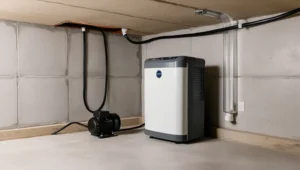
In basement areas the drain line is a problem. Because in most of the basement there are no proper lines for water drainage. So first you need to connect the drain pipe with the dehumidifier drain line. Then buy a pump motor and connect the pump motor to the drain pipe. This pump motor can drain the water Basement to Ground floor.
Nowadays there are a lot of dehumidifiers available for the basement, which have inbuilt pump motors. In my personal experience, those inbuilt pump motor wear out quickly. Because of that, I suggest you to buy a separate pump motor. They are more reliable and good quality compared to the inbuilt pump motor in the dehumidifier.
Different kinds of modes to get more control over the dehumidifier:
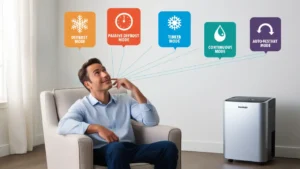
Nowadays dehumidifiers are smarter than ever. There are so many different modes that make us a smart user and we can use those modes to make our place more comfortable. Like Defrost mode, Passive defrost mode, Timer mode, Continuous mode and Auto-restart mode. Here I have described them:
Defrost mode: In cold areas, sometimes dehumidifiers freeze up and for those issues, companies provide this mode. The old model dehumidifier has this setting. In cold weather, compressor-based dehumidifiers get frizzed. Defrost mode was invented to avoid this issue. what it does is, it automatically turn off the refrigeration cycle of the dehumidifier and it will only run its fan. So this fan slowly melts the ice from the dehumidifier. After the ice is fully melted, it runs again.
Passive defrost mode: Companies now provide passive defrost mode in modern dehumidifiers. It is an optimized version of the deforest mode. In this mode, the dehumidifier is not actively dehumidifying, but still, it consumes electricity. So this mode is less efficient compared to the deforest mode but provides a high value.
This mode allows the dehumidifier to operate at a very low temperature. We know that the compressor-based dehumidifier gets frizzed, if we use it in a place where the temperature is lower than 17/18 °C. But because of this mode, now the dehumidifier can run at 5°C temperature. At this temperature, it runs in a very low setting. This is crazy that modern dehumidifiers are improving so much. For more lower temperature go for the desiccant dehumidifier.
Passive defrost in a dehumidifier is an important mode you need to have for basement areas because the basement is colder than room temperature.
Timer mode: It’s a very common mode, most dehumidifiers on the market come with a timer. Imagine you need to go out for some work, before you go out you set the timer mode for 4 hours. After 4 hours it will turn off automatically. so that when you come home you find your place more comfortable.
Continuous mode: It is used in very humid areas like basements after rain & places where mold is a massive issue. Normally modern dehumidifier has a sensor when you achieve the required humidity level, it turns off automatically. But continuous mode doesn’t off automatically. it will run until you turn it off.
Auto-restart: Imagine you are using continuous mode or another mode on your dehumidifier and due to load shading the dehumidifier is off now. Once the power is available, the dehumidifier will run in the same mode, that you set before. Every dehumidifier has this setting.

